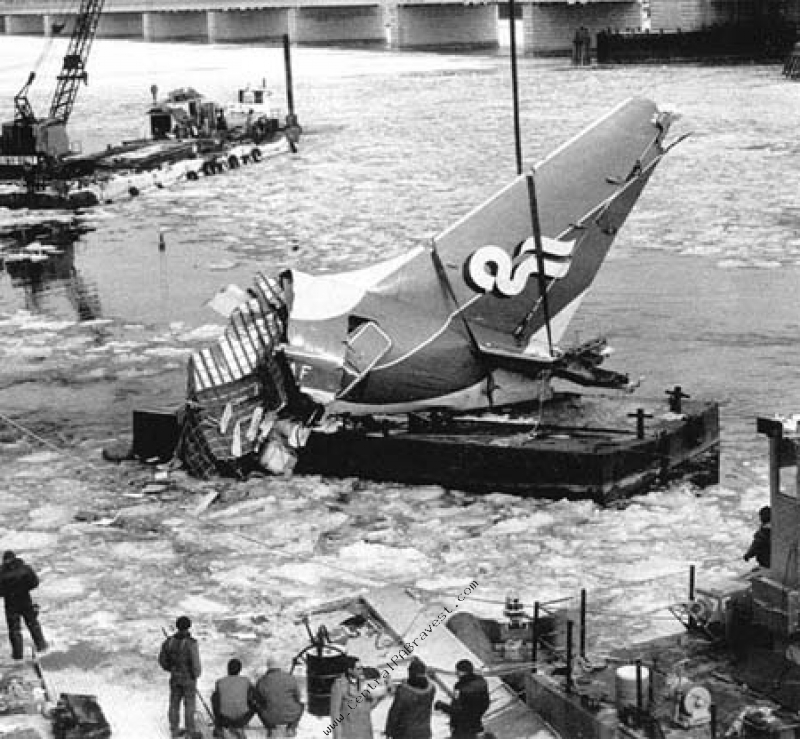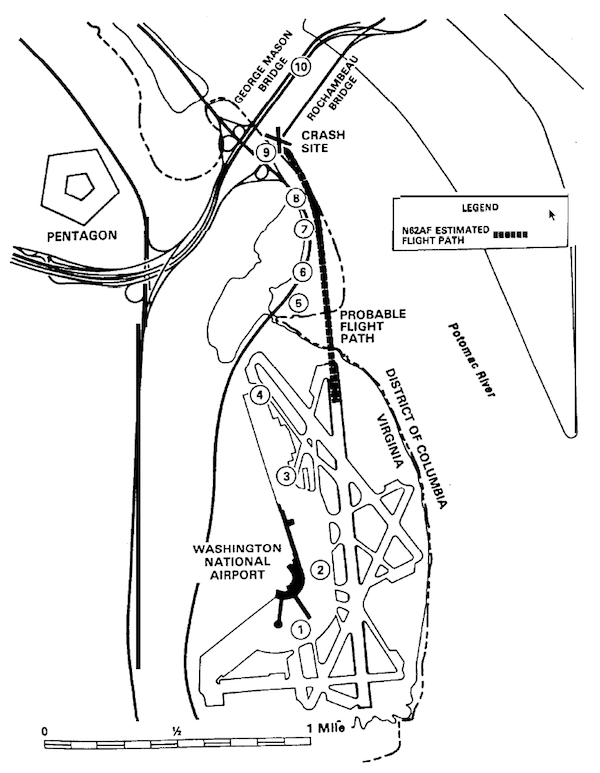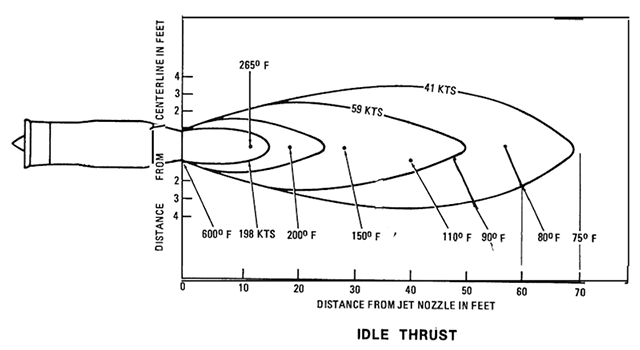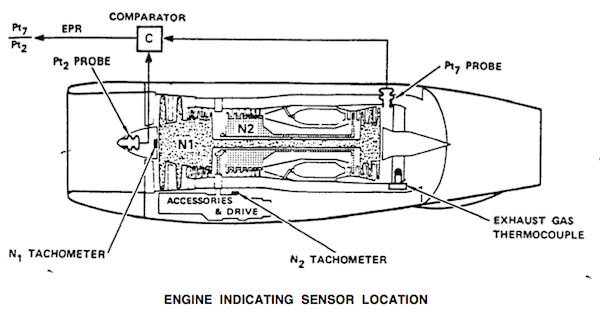There are many lessons from this mishap, some of which seem pretty obvious in hindsight. But one lesson in particular should hit home for those of us who have a lot of experience flying aircraft. If you are in a cockpit with more than one pilot and the other pilot isn't comfortable, perhaps he or she understands something you don't.
— James Albright

Updated:
2014-05-27
Whenever ever I hear the other pilot say "I don't think that's right," I immediately say, "explain." Maybe he or she sees something I don't. Sometimes the safest thing you can do on the ground is set the parking brake and think things through.
As for the lessons learned in this particular accident, these might seem rather obvious:
- If you are still in conditions conducive to ice, snow, or frost accumulation, you need to check the aircraft prior to takeoff. Getting de-iced and anti-iced does not relieve you of this responsibility.
- Do not use reverse thrust for push back with snow or ice on the ramp.
- Use engine anti-ice according to your flight manual procedures.
- Increase your distance behind other aircraft when taxiing over contaminated surfaces.
- Monitor engine performance.
- At any point you think you need additional performance, push the throttles forward.
- If the other pilot voices a concern, listen and consider.
There is one more lesson to consider, especially if you are in the business of hiring pilots. Just because a pilot has all the necessary licenses and meets the minimum hours listed on your qualification documents, doesn't mean the pilot has the necessary experience to fly your operation. The pilot may be a good hire, but further evaluation is needed to ensure the pilot is properly trained.

1
Accident report
- Date: 13 JAN 1982
- Time: 16:01 EST
- Type: Boeing 737-222
- Operator: Air Florida
- Registration: N62AF
- Fatalities: 4 of 5 crew, 70 of 74 passengers
- Aircraft Fate: Destroyed
- Phase: Initial climb
- Airport: (Departure) Washington-National Airport, DC (DCA) (DCA/KDCA), United States of America
- Airport: (Destination) Tampa International Airport, FL (TPA) (TPA/KTPA), United States of America
2
Narrative
Flight 90 was scheduled to depart Washington National Airport at 1415 e.s.t. . . . Snow was falling throughout the early afternoon.
About 1420, American Airlines maintenance personnel began deicing the left side of the fuselage. . . . Fluid had been applied to an area of about 10 feet when the captain terminated the operation because the airport was not going to reopen at 1430.
Between 1445 and 1450, the captain requested that the deicing operation be resumed. The left side of the aircraft was deiced first.
Between 1445 and 1500 the operator of the deicing vehicle was relieved from this deicing task, and he told his relief operator, a mechanic, that the left side of the aircraft had been deiced. The relief operator proceeded to deice the right side of the aircraft.
Source: NTSB Aircraft Accident Report, AAR-82-8, §1.1
The aircraft was deiced about 50 minutes prior to its eventual takeoff. The report, page 56, notes: "The Safety Board is concerned that pilots may erroneously believe that there is a positive protection provided for a period following the application of deicing/anti-icing solution which eliminates the need to closely monitor the aircraft for contaminants during ground and takeoff operations. The Safety Board concludes that the only way to assure that the deicing process has been effective and that the aircraft is clean of adhering ice, snow, or frost, is by observation by the flight crew just before takeoff roll." Of course we have made a lot of progress since this mishap, but don't think you can always use the holdover tables or that they remove the obligation for a pretakeoff contamination check.
More about this: Cold Weather Operations.
A tug was standing by to push Flight 90 from gate 12. . . . At 1525, the tug attempted to push Flight 90 back. However, a combination of ice, snow, and glycol on the ramp and a slight incline prevented the tug, which was not equipped with chains, from moving the aircraft. When a flight crewmember suggested to the tug operator that the aircraft's engine reverse thrust be used to push the aircraft back, the operator advised the crewmember that this was contrary to the policy of American Airlines. According to the tug operator, the aircraft's engines were started and both reverser's were deployed. He then advised the flightcrew to use only "idle power."
Source: NTSB Aircraft Accident Report, AAR-82-8, §1.1
Boeing warns against the use of reverse thrust in this situation because of occurrences of takeoff pitch control anomalies with the B-737 after ground operation in freezing conditions. This warning was incorporated into Air Florida flight manuals.
The flight manual required the use of engine anti-ice under these circumstances and there were no restrictions against its use. Furthermore, there was no significant performance penalty for its use during takeoff and climb.
Witnesses estimated that both engines were operated in reverse thrust for a period of 30 to 90 seconds. During this time, several Air Florida and American Airlines personnel observed snow and/or slush being blown toward the front of the aircraft. One witness stated that he saw water swirling at the base of the left (No. 1) engine inlet. Several Air Florida personnel stated that they saw an area of snow on the ground melted around the left engine for a radius of 6 to 15 feet. No one observed a similar melted area under the right (No. 2) engine.
When the use of reverse thrust proved unsuccessful in moving the aircraft back, the engines were shut down with the reversers deployed. The same American Airlines mechanic that had inspected both engine intakes upon completion of the deicing/anti-icing operation performed another general examination of both engines. He stated that he saw no ice or snow at that time.
[After a second tug was hooked up] At 1535, Flight 90 was pushed back without further difficulty.
No witnesses saw the flight crew leave the aircraft to inspect for snow/ice accumulations while at the gate. Departing and arriving flight crews and others who saw Flight 90 before and during takeoff stated the aircraft had an unusually heave accumulation of snow or ice on it.
At 1538:16 while accomplishing the after-start checklist items, the captain responded "off" to the first officer's callout of checklist item "anti-ice." [The aircraft was cleared to taxi behind a New York Air DC-9, call sign Apple 4]
At 1540:42, the first officer continued to say, "it's been a while since we've been deiced." At 1546:21, the captain said, "Tell you what, my windshield will be deiced, don't know about my wings." The first officer then commented, "well--all we need is the inside of the wings anyway, the wingtips are gonna speed up on eight anyway, they shuck all that other stuff." At 1547:32, the captain commented, "(Gonna) get your wing now." Five seconds later, the first officer asked, "D'they get yours? Did they get your wingtip over 'er?" The captain replied, "I got a little on mine." The first officer then said, "A little, this one's got about a quarter to half an inch on it all the way."
Source: NTSB Aircraft Accident Report, AAR-82-8, §1.1
It appears the captain was attempting to use the jet blast from the aircraft in front of him to deice his airplane, varying his position in the taxiway to get various portions of his aircraft.
Of course taxiing closely behind another aircraft in these conditions would have the opposite effect from what was intended. From page 61: "The Safety Board believes the heat of the exhaust gases may have turned snow, which otherwise might have blown off during takeoff, into a slushy mixture. The mixture then froze on the wing leading edges and the engine inlet nose cone. The flight manual states: "Maintain a greater distance than normal between airplanes when taxiing on ice or snow covered areas. Engine exhaust may form ice on the ramp and takeoff areas of the runway and blow snow and slush which freezes on surfaces it contacts.
At 1548:59, the first officer asked, "See this difference in that left engine and the right one?" The captain replied, "Yeah." The first officer then commented, "I don't know why that's different — unless it's hot air going into that right one, that must be it — from his exhaust — it was doing that at the chocks awhile ago. . . .ah." At 1551:54, the captain said, "Don't do that — Apple, I need to get the other wing done."
Source: NTSB Aircraft Accident Report, AAR-82-8, §1.1
Post accident simulator tests led the investigators to conclude that the left engine Pt2 engine probe was blocked, causing the anomaly the first officer spotted.
...the tower transmitted the takeoff clearance and the pilot acknowledge, "Palm 90 cleared for takeoff."
The CVR indicated that the pretakeoff checklist was completed at 1559:22. At 1559:45, as the aircraft was turning to the runway heading, the captain said, "Your throttles." At 1559:46, the sound of engine spool up was recorded, and the captain stated, "Holler if you need the wipers." At 1559:56, the captain commented, "Real cold, real cold," and at 1559:58, "the first officer remarked, "God, look at that thing, that don't seem right; does it?"
Source: NTSB Aircraft Accident Report, AAR-82-8, §1.1
Most of the engine instruments were damaged from the impact or the water, but simulator tests show the flight path could be approximated with an engine EPR setting of 1.70, versus the 2.04 target. Tests of the engine EPR system also showed that with a blocked Pt2 probe, the probe senses vent pressure and will indicate 2.04 EPR with the engine actually operating at 1.70. Had they activated the engine anti-ice system, they would have "immediately notice a substantial drop in the indicated EPR."
Between 1600:05 and 1600:10, the first officer stated, "...that's not right...," to which the captain responded, "Yes it is, there's eighty." The first officer added, "...maybe it is," but then 2 seconds later, after the captain called, "hundred and twenty," the first officer said, "I don't know."
Source: NTSB Aircraft Accident Report, AAR-82-8, §1.1
The aircraft pitched higher than normal during the rotation because of contamination on the wing.
Eight seconds after the captain called "Vee one" and 2 seconds after he called "Vee two," the sound of the stick shaker was recorded. At 1600:45, the captain continued, "Come on, forward, forward, just barely climb." At 1610:00, the first officer said, "Larry, we're going down, Larry," to which the captain responded, "I know it."
Source: NTSB Aircraft Accident Report, AAR-82-8, §1.1
Simulator tests verify that had they increased thrust at any point from after liftoff until about 15 seconds, they could have pulled out of the descent and continued the climb.
About 1601, the aircraft struck the heavily congested northbound span of the 14th Street Bridge, which connect the District of Columbia with Arlington County, Virginia, and plunged into the ice-covered Potomac River.
Source: NTSB Aircraft Accident Report, AAR-82-8, §1.1
3
Analysis
Ground operations after deicing
Although the Safety Board could not determine whether the aircraft was completely free of snow or ice immediately after the deicing operation was completed, evidence is conclusive that snow had accumulated on the surfaces during the nearly 50 minutes of exposure to moderate to heavy snowfall before Flight 90 was cleared for takeoff.
Since other flights departing Washington National Airport during the snowfall on January 13 also experienced extensive delays and performed without apparent difficulty during takeoff, one might conclude that the deicing procedures used on those aircraft were more effective than those used on Flight 90. However, the exact conditions, such as temperature and ground accumulation on ramps and taxiways, the length of time the aircraft was exposed to critical wind conditions, and the proximity of the aircraft to the exhaust gases of other aircraft after deicing, are all factors which could have made the difference between a successful takeoff and an unsuccessful one. While other departing aircraft may also have had some snow on their surfaces, the Safety Board believes that the manner in which the flightcrew of Flight 90 operated their aircraft before and during the taxi and ground delay increased the aircraft’s susceptibility to aerodynamically degrading contamination.
Although the captain was solely responsible for assuring that the aircraft was ready for flight when it left the gate, no witnesses specifically recalled seeing either the captain or the first officer leave the cockpit to inspect the aircraft from the outside for remaining snow or ice contamination. Surviving passengers testified that the crew remained in the cockpit following the deicing operation. The Safety Board, therefore, concludes that the flightcrew’s assessment of the aircraft’s condition was based entirely on their discussions with maintenance personnel and any observations made from the cockpit. Although the Safety Board places no causal significance to the postdeicing inspection because of the subsequent ground operations and the lengthy exposure of the aircraft to the continuing snowfall while awaiting takeoff clearance, it believes that good practice dictates that one of the flight crewmembers observe the aircraft from outside.
Source: NTSB Aircraft Accident Report, AAR-82-8, ¶2.4 - 2.5
Commercial operators now have the flexibility of delegating the post deicing inspection to qualified ground personnel, provided everyone concerned has been trained to do this.
The surface condition in the gate area was slippery and the tug which was connected to the aircraft for the pushback after the aircraft was deiced could not develop the traction needed to move the aircraft. After it was apparent that the aircraft could not be moved with the tug, the flightcrew started the engines and used reverse thrust to help pushback, contrary to advice from the tug operator that the use of reverse thrust was prohibited by American Airlines’ policy. Witnesses estimated that the engines were operated for 30 to 90 seconds during which time snow and slush were blown around the aircraft. The aircraft failed to move even with the combined effort of reverse thrust and the tug, and the engines were shut down.
The Safety Board believes that the flightcrew was influenced by the prolonged airport closure and by additional delays at pushback, leading them to use reverse thrust to expedite operations. Regardless, the Safety Board concludes that the flightcrew’s actions in using reverse thrust contrary to advice and guidance provided indicates a lack of Professional judgment consistent with their total performance.
The Safety Board's investigation established conclusively that the engine anti-ice system was not used during ground operations of Flight 90. The crew's response to anti-ice during the "after-start" checklist was "off."
The Safety Board concludes that the flightcrew’s failure to use engine anti-ice was a direct cause of the accident. Had the engine inlet Pt2 probes not been blocked by ice, the correct EPR values would have been indicated during the takeoff power adjustments, and the engines would have been set for and developed normal thrust for takeoff and climb.
The CVR-recorded conversation between the captain and first officer as they awaited their sequenced departure indicated that the captain intentionally positioned his aircraft close behind another aircraft in an attempt to use heat and blast from exhaust gases to remove visible snow or slush from the wings. Within 3 minutes after the engines were started, the first officer commented, "It’s been a while since we’ve been deiced.” Five minutes later, the captain stated, “Tell you what, my windshield will be deiced don’t know about my wing.” The first officer responded, “Well, all we really need is the inside of the wings anyway, the wingtips are gonna speed up by eighty anyway, they’ll shuck all that other stuff.”
The Safety Board believes that the heat of the exhaust gases may have turned snow, which otherwise might have blown off during takeoff, into a slushy mixture. The mixture then froze on the wing leading edges and the engine inlet nose cone. The Safety Board believes that the captain’s actions to position the aircraft in the area of heated exhaust gases of preceding aircraft may have contributed to this accident by increasing the amount of the frozen contaminant which adhered to critical parts of the aircraft prior to and during the takeoff.
The Safety Board views the action to taxi close to the aircraft ahead as an example of the captain’s lack of awareness of, or disregard for, the contents to the flight manual. Operations Manual Bulletin No. 74-8, issued by The Boeing Co. on October 24, 1974, called specific attention to the cold weather procedures of the FAA-Approved Flight Manual. The manual states, ‘Maintain a greater distance than normal between airplanes when taxiing on ice or snow covered areas. Engine exhaust may form ice on the ramp and takeoff areas of the runway and blow snow and slush which freezes on surfaces it contacts.”
Regardless of the many factors which may have influenced the flightcrew, the Safety Board concludes they should not have initiated a takeoff with snow visible on the aircraft wings.
Flightcrews routinely reverse duties on alternate legs of flight; however, the captain remains in the left seat. On the accident flight, the first officer was to conduct the takeoff. There are no written procedures in the Air Florida Operations Manual to specify the reversal of duties between the captain and first officer; however, such procedures are standardized during training. The captain must still control the aircraft until it is aligned with the runway centerline using the nosewheel steering tiller. The first officer will set the engine thrust levers to the target EPR value. When the aircraft is aligned with the runway, the first officer will assume directional control of the aircraft using the rudder pedal steering. He will release his left hand from the throttle levers, and the captain will make final power adjustments and keep his right hand on the throttle levers so that he may initiate a rejected takeoff if necessary. During the takeoff acceleration, the first officer would normally be looking outside to maintain directional control with a scan to the airspeed indicator. The captain’s attention would be directed to checking engine instruments and monitoring flight instruments. He would make the required 80-knot, V1 and VR calls. Even with the reversal of takeoff duties, the captain remains responsible or the fina1 decision to reject a takeoff.
Within 10 seconds of the initial power adjustment, the first officer commented, “That don’t seem right does it?” “Ah, that’s not right.” The captain’s only response was “yes it is, there’s eighty” (knots). The first officer again expressed concern, “Naw, I don’t think that’s right.” Again, there was no response from the captain.
Although the first officer advised the captain of his concerns several times, the captain apparently chose to ignore his comments and continue the takeoff. It is not necessary that a crew completely analyze a problem before rejecting a takeoff on the takeoff roll. An observation that something is not right is sufficient reason to reject a takeoff without further analysis, The problem can then be analyzed before a second takeoff attempt.
Source: NTSB Aircraft Accident Report, AAR-82-8, ¶2.3 - 2.5
Engine setting during takeoff
The evidence is conclusive that the aircraft’s acceleration during the takeoff roll and its subsequent climb and acceleration were subnormal. A normal B-737 at the weight of the accident aircraft and under the existing environmental conditions should accelerate in about 30 seconds to a liftoff at about 145 kns indicated airspeed (KIAS) using about 3,500 feet of runway. The aircraft should then climb more than 2,000 feet/minute while transitioning to the climb configuration. By contrast, the CVR and FDR showed that the accident aircraft took about 45 seconds and used about 5,400 feet of runway before it lifted off at an airspeed between 140 and 145 kns. The accuracy of the FDR recorded altitude following liftoff is questionable; however, it appears that the aircraft achieved an initial, short-term rate of climb of about 1.200 feet/minute. The stickshaker, indicating an approach to stall angle of attack, activated almost immediately after liftoff. Upon reaching an altitude of between 200 and 300 feet, the airspeed began to decrease and the FDR vertical acceleration parameter and the descriptions provided by surviving passengers showed that the aircraft encountered stall buffet before descending to hit the bridge.
While both increased aerodynamic drag, such as that produced by an accumulation of airframe ice, and increased rolling drag, such as that produced by an accumulation of snow or slush on the runway surface, would result in subnormal acceleration, the Safety Board did not believe that these factors alone would account for the performance deficiency evident in this accident. Furthermore, the recorded cockpit conversation between the captain and first officer during takeoff indicated that the first officer was concerned about the appropriateness of some cockpit instrument readings. This suggested possible uncertainty about the engine thrust level. Therefore, the CVR tape was analyzed to correlate the dominant frequencies of the recorded engine noise with engine rotational speed and thrust. This sound spectrum analysis disclosed a significant disparity between the engine (N1) rotational speed developed during and following the takeoff roll and the rotational speed which would correspond to the target takeoff power setting.
The primary instrument used by B-737 pilots to set and monitor thrust on the Pratt & Whitney JT8D engines is EPR, a direct indication of the ratio of the pressure measured at the engine discharge (Pt7) to the pressure measured at the compressor inlet (Pt2). The target value for takeoff is determined for existing’ conditions before the flight. For the accident flight, the appropriate takeoff EPR setting was determined to be 2.04.
Since the weather conditions at the time of the accident were conducive to the formation of ice on the Pt pressure probe as well as on other parts of the airframe, the Safety Board conducted extensive tests and analyses to determine the effects of an ice-blocked Pt2 probe on engine EPR indications. The tests confirmed that ice blockage of the Pt2 probe will affect the EPR reading such that the flightcrew will observe a false indication of takeoff thrust when the throttles are set for takeoff. The tests further showed that the direction of the EPR indication error is dependent upon whether the engine anti-ice system is on or off. With engine anti-ice off, the EPR instrument will indicate higher thrust level than is actually being developed by the engine. The tests and analysis showed that had the flightcrew set the throttles to achieve an EPR indication of 2.04, the actual thrust which would be developed presuming an ice blocked Pt2 probe would equate to an (unblocked Pt2 probe) EPR of 1.70. The corresponding engine rotational speed for this reduced thrust level correlated closely with the engine rotational speeds actually developed on the accident aircraft during takeoff, as determined from the CVR sound spectrum analysis.
One function of the engine anti-ice system is to maintain a flow of heated air at the Pt2 probe to prevent ice formation and blockage. Strong evidence from the accident investigation -- namely the postimpact closed position of the engine anti-ice valves, valves which are electrically motor driven and thus not susceptible to position changes by impact loading -- indicates that the engine anti-ice system was off at the time of impact. The CVR recording substantiated that the engine anti-ice system had not been used during the pretakeoff ground operation.
Source: NTSB Aircraft Accident Report, AAR-82-8, ¶2.3
The first officers call, "...that's not right...," was prompted by his feeling that the engines gauges were not matching normal throttle lever position and aircraft acceleration.
Wing ice impact
Ground witnesses and surviving passengers stated that they had observed an accumulation Of snow or ice on the upper fuselage and wings of the aircraft before and during the takeoff roll. The conversation between pilots as recorded on the CVR also indicated that they were aware that l/4 to l/2 inch of snow was present on the wing surfaces. Snow or slush adhering to the surfaces of an aircraft, particularly to the airfoil surfaces, will degrade any aircraft’s aerodynamic performance.
[. . . ] the Safety Board concludes that the activation of the aircraft’s stickshaker and the onset of stall buffet at airspeeds significantly higher than the airspeeds at which those events would theoretically occur are positive evidence that snow or ice was adhering to the airplane and degrading its aerodynamic performance.
Aside from altering the lift-producing properties of the wing surfaces, the most significant detrimental effect of snow or ice contamination on performance is the increase in the aircraft’s total drag, that is, the force which resists the aircraft’s forward motion through the air. The total drag has two components, induced drag and parasite drags both of which vary with the aircraft’s speed. Induced drag is that drag which is produced by the generation of lift. It is proportional to lift and the proportion increases as angle of attack increases. Therefore, since a contaminated wing must fly at a higher angle of attack at a given airspeed to produce the required lift, the induced drag generated at that airspeed will be higher than the induced drag of an uncontaminated wing. Parasite drag, is that force produced by the frontal area of the aircraft as it pushes the air aside and the friction created as the air moves over the aircraft surface. Although the parasite drag component is most significant at high speed, there can be a considerable increase in parasite drag at any speed if an aircraft is contaminated with snow. The aircraft’s frontal area is increased by the increased angle of attack required and by the additional area of the contaminant itself. The friction created will increase because of the roughness of the contaminated surface. Therefore, the total drag of an aircraft will be greater at any given airspeed when snow or ice adheres to its surface.
The increased drag of the aircraft caused by the snow contamination was a major factor in this accident, particularly when combined with the lower-than-normal takeoff thrust brought about by the erroneous EPR indication. In order to maintain stabilized, level and unaccelerated flight, the aircraft’s lift must equal its weight and the thrust produced by the engines must be equal to the drag. To climb at a steady airspeed, to accelerate to a faster airspeed in level flight, or to achieve any combination of climb and acceleration, thrust must be greater than drag.
Source: NTSB Aircraft Accident Report, AAR-82-8, ¶2.3
Flight crew experience and training
Source: NTSB Aircraft Accident Report, AAR-82-8, ¶2.6
The captain and first officer of Flight 90 were certificated and qualified in accordance with applicable regulations. However, the Safety Board believes that the flightcrew’s performance on January 13 reflected an insufficient concern for the hazards of cold weather operations which was not consistent with the intent of the regulations. The Safety Board could not determine the level of training in cold weather operations or the amount of exposure to actual cold weather conditions that either crewmember had before his employment with Air Florida.
The captain’s flying experience before his employment with Air Florida, Inc., included flying light aircraft, twin reciprocating aircraft and turboprop-powered aircraft. Much of his flying is known to have been in the southern United States. All of his jet transport training and experience were obtained with Air Florida. Before his checkout as a B-737 captain, his jet flight experience consisted of about 1,200 hours as a first officer on DC-9 and B-737 aircraft. Since upgrading to captain, he had accumulated about 1,100 hours. The Safety Board’s review of his operating experience as a captain disclosed only eight previous occasions where arrivals or departures were conducted during weather conditions conducive to icing.
The first officer’s experience before his employment with Air Florida, Inc., was gained as a military jet fighter pilot. His direct experience in jet transport-type aircraft consisted of about 1,000 hours as a first officer in B-737 aircraft. The Safety Board’s investigation disclosed only two occasions during that period where he had conducted ground operations in conditions conducive to icing. Thus, neither of the flightcrew had much experience in operating jet transport aircraft in weather conditions like those at Washington National Airport on January 13, 1982.
The Safety Board concludes that the flightcrew’s limited training and low experience in jet transport winter operations in snow and ice conditions were contributing factors in this accident. The Board believes that the captain of Flight 90 missed the seasoning experience normally gained as a first officer as a result of the rapid expansion of Air Florida, Inc., from 1977 through 1981, wherein pilots were upgrading faster than the industry norm to meet the increasing demands of growing schedules.
Source: NTSB Aircraft Accident Report, AAR-82-8, ¶2.3
4
Cause
The National Transportation Safety Board determines that the probable cause of this accident was the flightcrew's failure to use engine anti-ice during ground operation and takeoff, their decision to take off with snow/ice on the airfoil surfaces of the aircraft, and the captain’s failure to reject the takeoff during the early stage when his attention was called to anomalous engine instrument readings. Contributing to the accident were the prolonged ground delay between de-icing and the receipt of ATC takeoff clearance during which the airplane was exposed to continual precipitation, the known inherent pitch up characteristics of the B-737 aircraft when the leading edge is contaminated with even small amounts of snow or ice, and the limited experience of the flight crew in jet transport winter operations.
Source: NTSB Aircraft Accident Report, AAR-82-8, §3.2.
References
(Source material)
NTSB Aircraft Accident Report, AAR-82-8, Air Florida, Inc., Boeing 737-222, N62AF, Collision with 14th Street Bridge Near Washington National Airport, Washington, D.C., January 13, 1982



